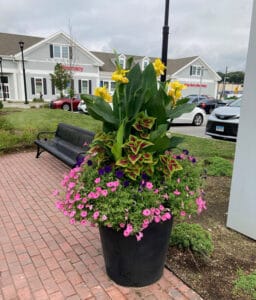Drip Irrigation System Vs. Self Watering Planters
 Drip irrigation
Drip irrigation
Drip irrigation is the process of delivering water to plants through a series of tubes, pipes and emitters. Similar to self-watering planters, drip irrigators deliver water directly to the roots of plants, minimizing water waste due to evaporation and runoff.
In a typical drip irrigation system, water is transported to the soil from a water source (such as a hose or water supply line) using a network of tubing or pipes. Along the tubing, small devices called emitters or drippers are strategically placed near the base of each plant.
These emitters release water slowly and consistently, allowing the soil to absorb the water where it’s needed the most– at the plant’s root system.
There are lots of benefits of drip irrigation systems, including water conservation, reduced weed growth, reduced spillage and runoff. Drip irrigation is widely used in agriculture, landscaping, gardening and even in some container plants.
While drip irrigation systems offer many advantages over traditional top-down watering, these systems are not without their drawbacks. Drip irrigation emitters often become clogged due to sediment, minerals, or organic matter. This can cause water blockages and leaks and these emitters do require fairly frequent maintenance and monitoring.
Secondly, if not configured properly, drip irrigation systems can lead to shallow root growth. Also, drip irrigation systems require a constant flow of water. This means that hoses are visible and must connect to the planter. This can be a trip hazard and an eye-sore. Lastly, the cost of setting up a drip-irrigation system is significantly higher than the one time cost of a self-watering planter.
The Benefits of Self-Watering Planters
Self watering planters have a large water reservoir at the bottom of the planter that feeds the plant from the bottom up. This keeps the water away from the Sun’s rays and dramatically reduces evaporation. They have no parts that require constant maintenance or monitoring.
Once you fill the planter, over time, the water from the interior reservoirs is then pulled up into the soil using wicking and capillary action. The wicking chambers in our planters allow water from the reservoir to deliver a consistent level of moisture directly to the root system, ensuring optimal plant growth.
Your job is to simply fill the planters with a garden hose once every couple of weeks and your plants will stay adequately watered, even in the hottest months of the year. To learn more about this process, see our video here.
Drip irrigation systems are clearly well-suited to larger agricultural situations, but for smaller, more contained areas, self-watering planters require substantially less maintenance and worry.
They are more economically viable for most and there is a lot less chance of water leaks that could lead to significant clean-up costs. The choice is simple: the most economical and attractive self-watering option is a self-watering planter.
100% Satisfaction Warranty
If you have any problems with your self watering planter, we’ll make it right. Click the image below to see our outstanding warranty.
If you have any questions about any of our products, please contact us and we’ll get back to you as soon as we can.





